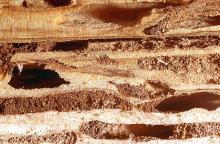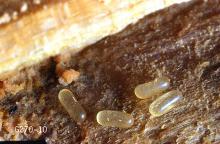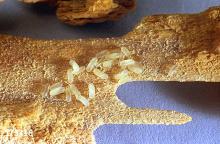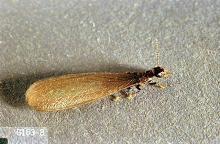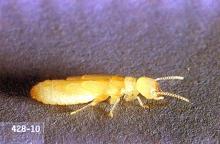Termites are among the most important structural insect pests in the PNW, rivaled only in certain areas by carpenter ants. They feed on wood, paper, cardboard, and other cellulose-containing material. Experts have estimated that termites cause as much property damage each year in the U.S. as fire (over $5 billion according to the National Pest Management Association).
There are two common species of termites in the PNW: the western subterranean termite (Reticulitermes hesperus) and the Pacific dampwood termite (Zootermopsis angusticollis). A third species, the drywood termite (Incisitermes minor), has been found occasionally but there is no evidence that it has become established. The drywood termite occurs in furniture or lumber imported from southern states. The western subterranean termite is more common east of the Cascade Mountains, whereas the dampwood termite is more prevalent in western Washington and Oregon.
Western subterranean termite
Reticulitermes hesperus
Western subterranean termites are quite small. The reproductive form is approximately 0.38 inch in length, including wings. They are dark brown to black with brownish-gray wings. The worker caste is creamy-white, about 0.18 inch, long and resembles a grain of rice. They nest within cellulose material buried in soil, often inside stumps or logs that may be 10 to 20 feet or more below the surface.
Structure-infesting subterranean termites return to their soil nest to exchange food with colony members and to obtain water. Because damp wood is not essential for attack, any wooden structure is a potential site of invasion. Cement slab foundations are no deterrent since joints between slab and foundation walls, frost cracks, and areas around plumbing provide easy access to wood.
Termites gain entry to structures around porches and through steps, supporting posts, and sills that are close to or in contact with the soil. Occasionally they construct shelter tubes ("mud tubes") over concrete foundations to reach wood from the soil beneath.
Management-chemical and bait controls
Infestations of subterranean termites rarely go away on their own. Therefore, the services of a knowledgeable, licensed pest management professional should be obtained. Pesticide treatments for subterranean termites are intended to establish a chemical barrier between a subsoil nest and the house. However, newer bait treatments are designed to attract termites to bait stations containing a toxicant. Other pesticides do not kill upon contact but rather, allow termites to return to their nest and spread toxicant among colony members. Subterranean termite treatments can be complicated and very expensive, and should be left to the professional.
Management-biological
Entomophagous ("insect-eating") nematodes are sold for termite control. The concept is attractive, and there are many situations in which a biological answer is preferred over chemical insecticides. However, while these tiny worms have been effective in the laboratory under controlled conditions, they have not worked under real-world conditions. Factors such as soil moisture, nematode placement and persistence, and termite defensive mechanisms have been proposed as reasons for failures. Therefore, using nematodes for termite control is not recommended. Nematodes are not registered by the EPA, and, as a result, the protections afforded by registration are lacking.
Dampwood termite
Zootermopsis angusticollis
The Pacific dampwood termite is the largest termite species found in the PNW. Reproductive forms may exceed 1 inch in length, including the wings. Dampwood termites require wet or damp wood to infest and establish a colony. Wet wood may result from wood-soil contact, leaky plumbing, leaky roofs or gutters, and faulty grades on porches and patios. Wood decay fungus is often found in conjunction with this termite. Dampwood termites also attack wood that has become wet from condensation in poorly ventilated crawl spaces.
In most cases, management can be achieved by removing materials prone to infestation (wood scraps, construction forms), replacing structurally unsound wood, improving ventilation, and eliminating moisture problems. If the water issue is not corrected, the infestation will continue and damage from wood decay fungi then becomes problematic. Chemical applications alone will not eradicate this pest and should be discouraged.


